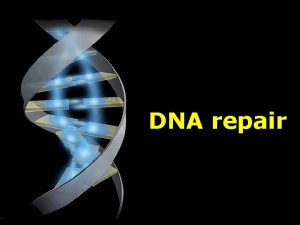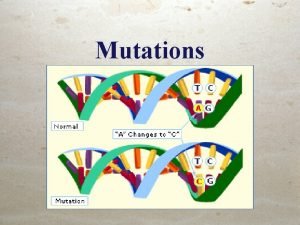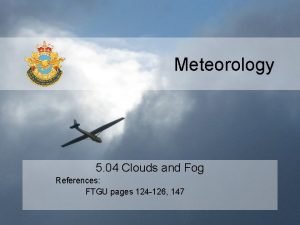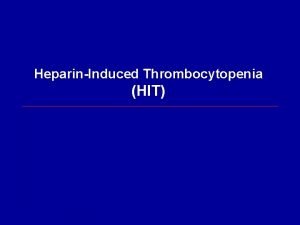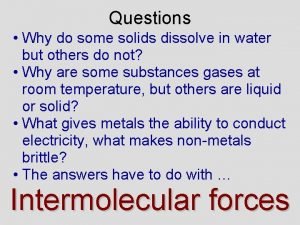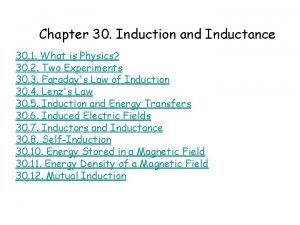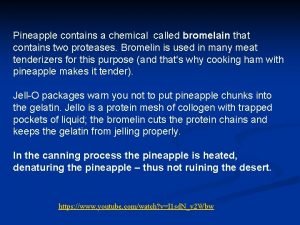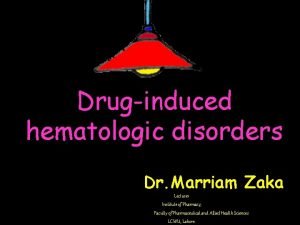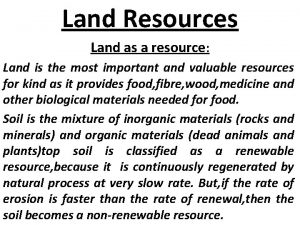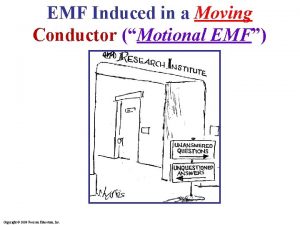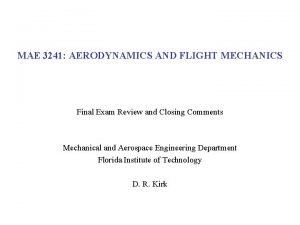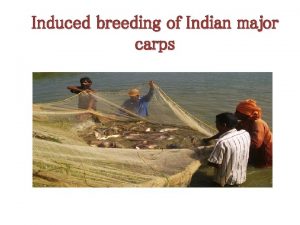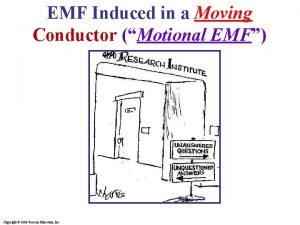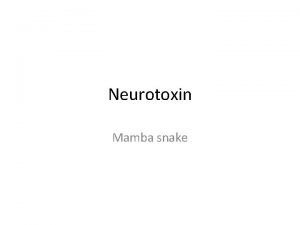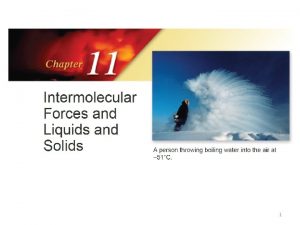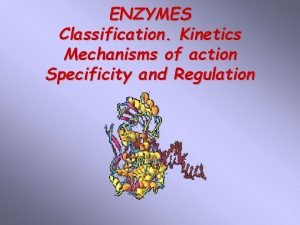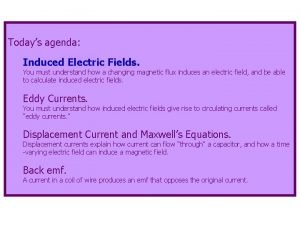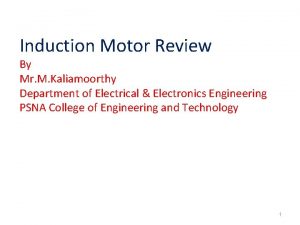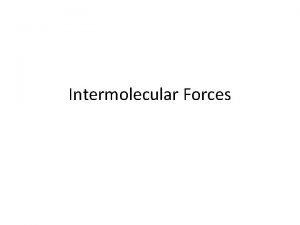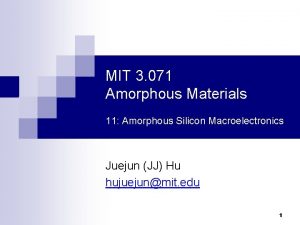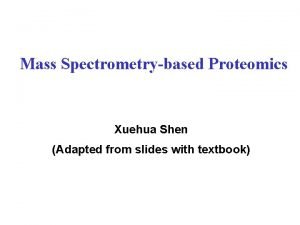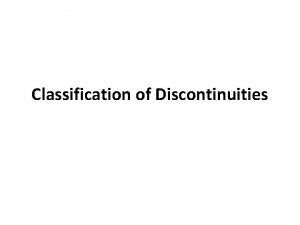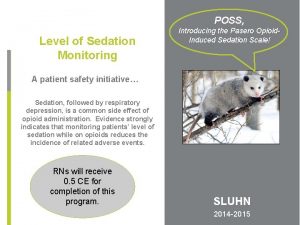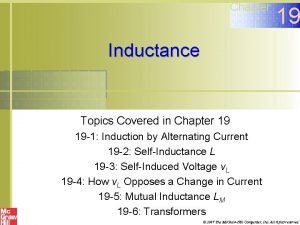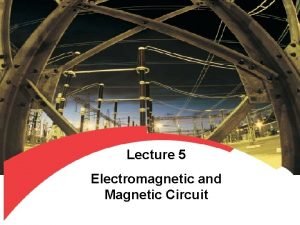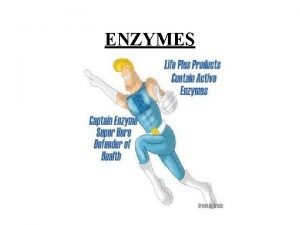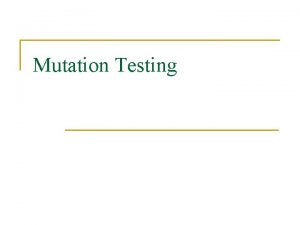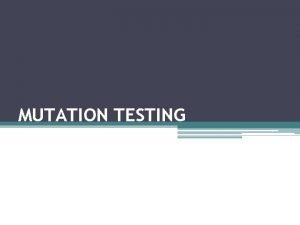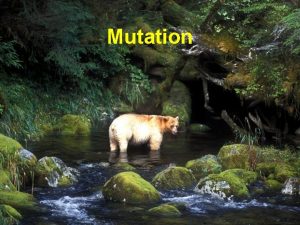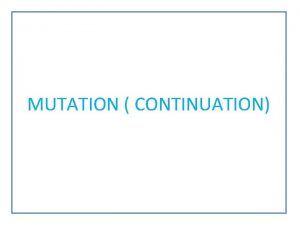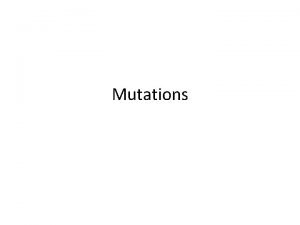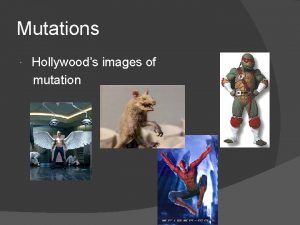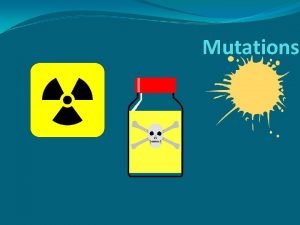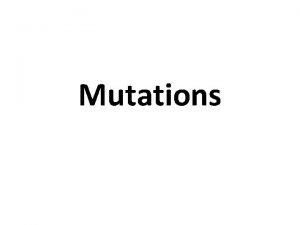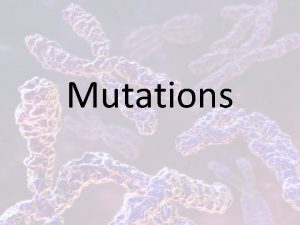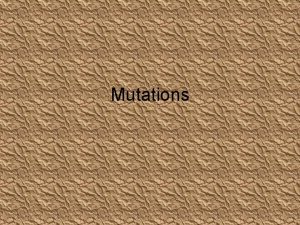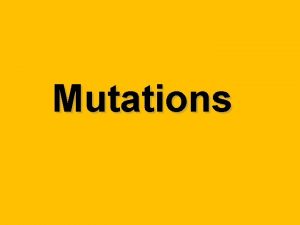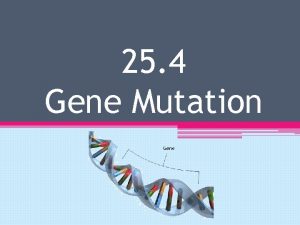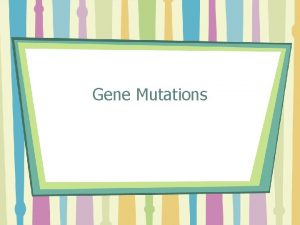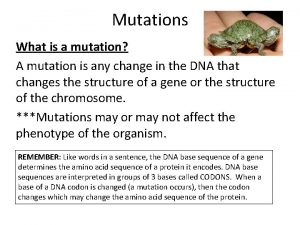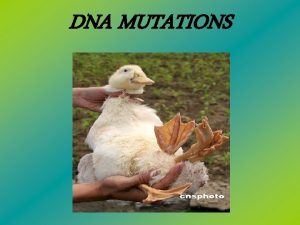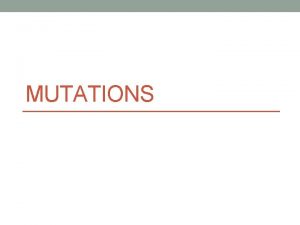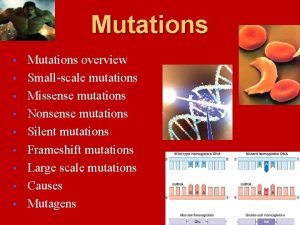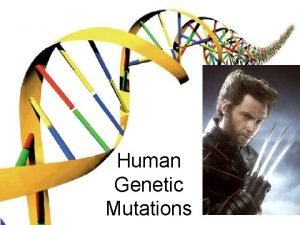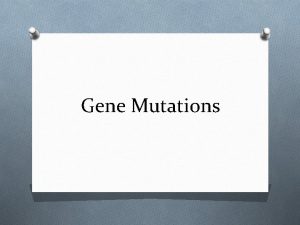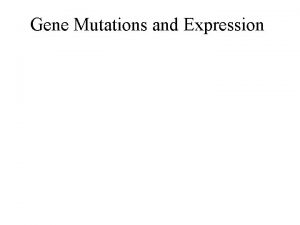MUTATION SPONTANEOUS MUTATIONS INDUCED MUTATIONS MUTATIONS Mutations are




























- Slides: 28

MUTATION SPONTANEOUS MUTATIONS & INDUCED MUTATIONS,

MUTATIONS • Mutations are heritable changes in the DNA. • They are essential to the study of genetics and are useful in many other biological fields. • Somatic mutations: occur in non reproductive cells. • Germ-line mutations: occur in cells that give rise to gametes.

Spontaneous mutations Mutations that are a result of natural changes in DNA structure. 1. All types of point mutations can occur spontaneously, during S, G 1 and G 2 phases of the cell cycle, or by the movement of transposons. 2. The spontaneous mutation rate in eukaryotes is between 10 -4 -to-10 -6 per generation, and in bacteria and phages 10 -5 -to-10 -7/generation. a. Genetic constitution of the organism affects its mutation rate. i. In Drosophila, males and females of the same strain have similar mutation rates. ii. Flies of different strains, however, may have different mutation rates. b. Many spontaneous errors are corrected by the cellular repair systems, and so do not become fixed in DNA.

Spontaneous mutations • • • Caused mainly by: Spntaneous replication errors. . 1. Tautomeric shifts 2. Wobble base pairing 3. Strand slippage 4. unequal crossing over 5. Spontaneous Chemical Changes : Depurination, Deamination

Tautomeric shifts Purine and pyrimidine bases exist in different chemical forms called tautomers • The positions of protons in the DNA bases change. •

Wobble base pairing • Normal, protonated, and other forms of the bases are able to pair because of flexibility in the DNA helical structure

Strand slippage • Strand slippage may occur when one nucleotide strand forms a small loop. • If the looped-out nucleotides are on the newly synthesized strand, an insertion results.

Unequal crossing over • During normal crossing over, the homologous sequences of the two DNA molecules align, and crossing over produces no net change in the number of nucleotides in either molecule. • Misaligned pairing may cause unequal crossing over • which results in one DNA molecule with an insertion and the other with a deletion

Spontaneous Chemical Changes • Depurination: the loss of a purine base from a nucleotide.

Deamination • Deamination: the loss of an amino group (NH 2) from a base. • Deamination may occur spontaneously or be induced by mutagenic chemicals.

INDUECED MUTATIONS

Induced Mutations • Mutations those that result from changes caused by environmental chemicals or radiation are called as induced mutations. • A number of environmental agents are capable of damaging DNA including certain chemicals and radiation. • Mutagen: Any environmental agent that significantly increases the rate of mutation above the spontaneous rate. • The first discovery of a chemical mutagen was made by Charlotte Auerbach

Induced Mutations Caused by; • Base analogs • Alkylating agents • Deamination • Hydroxylamine • Oxidative reactions • Intercalating agents • Radiation

Base analogs • chemicals with structures similar to that of any of the four standard bases of DNA. • DNA polymerases cannot distinguish these analogs from the standard bases; • so, if base analogs are present during replication, they may be incorporated into newly synthesized DNA molecules. • Eg. 5 -Bromouracil

5 -Bromouracil

Alkylating agents • chemicals that donate alkyl groups. These agents include methyl (CH 3) and ethyl (CH 3–CH 2) groups, which are added to nucleotide bases by some chemicals. • Example, ethylmethanesulfonate (EMS) adds an ethyl group to guanine, producing 6 -ethylguanine, which pairs with thymine.

Deamination • In addition to its spontaneous occurrence, deamination can be induced by some chemicals. • E. g. : nitrous acid deaminates cytosine, creating uracil, which in the next round of replication pairs with adenine producing a CG: TA transition mutation.

Hydroxylamine • Hydroxylamine is a very specific base modifying mutagen that adds a hydroxyl group to cytosine. • It converts cytosine into hydroxylaminocytosine. • This conversion increases the frequency of a rare tautomer. • The tautomer pairs with adenine instead of guanine and leads to CG: TA transitions. • Because hydroxylamine acts only on cytosine, it will not generate TA: CG transitions.

Oxidative reactions • Reactive forms of oxygen damage DNA and induce mutations by bringing about chemical changes to DNA. • Reactive forms of oxygen includes: • Superoxide radicals • Hydrogen peroxide • Hydroxyl radicals • They are produced in the course of normal aerobic metabolism, as well as by radiation, ozone, peroxides, and certain drugs.

Intercalating agents • Intercalating agents produce mutations by sandwiching themselves (intercalating) between adjacent bases in DNA. • They distorts the three-dimensional structure of the helix and causingle-nucleotide insertions and deletions in replication. • These insertions and deletions frequently produce frameshift mutations. • And so the mutagenic effects of intercalating agents are often severe. • Because intercalating agents generate both additions and deletions, they can reverse the effects of their own mutations. • E. g. : proflavin, acridine orange, ethidium bromide, and dioxin

Radiation • Ionizing radiation breaks covalent bonds including those in DNA and is the leading cause of chromosome mutations. • Ionizing radiation also frequently results in double-strand breaks in DNA • Ionizing radiation has a cumulative effect and kills cells at high doses. • UV (254 -260 nm) causes purines and pyrimidines to form abnormal dimer bonds and bulges in the DNA strands. • Eg : UV, X-Rays etc.

GENETIC MOSAICS

Genetic mosaics • Presence of two or more populations of cells with different genotypes in one individual who has developed from a single fertilized egg. • The phenomenon was discovered by Curt Stern.

Somatic mosaicism Somatic cells of the body are of more than one genotype. • Different genotypes arise from a single fertilized egg cell, due to mitotic errors at first or later cleavages. • In rare cases, Intersex conditions can be caused by mosaicism where some cells in the body have XX and others XY chromosomes (46, XX/XY). • Milder forms of Klinefelter syndrome, called 46/47 XY/XXY mosaic where in some of the patient's cells contain XY chromosomes, and some contain XXY chromosomes. • Around 30% of Turner's syndrome cases demonstrate mosaicism, while complete monosomy (45, X) occurs in about 50– 60% of cases. •

Gonadal mosaicism • Gonadal mosaicism or germline mosaicism is a special form of mosaicism, where some gametes, i. e. either sperm or oocytes, carry a mutation, but the rest are normal. • The cause is usually a mutation that occurred in an early stem cell that gave rise to all or part of the gonadal tissue. • This can cause only some children to be affected, even for a dominant disease.

Factors inducing mosaicism Endogenous factors: Mobile elements, DNA polymerase slippage, and unbalanced chromosomal segregation. • Exogenous factors : Nicotine and UV radiation. • Somatic mosaics have been created in Drosophila using x-ray treatment and the use of irradiation to induce somatic mutation has been a useful technique in the study of genetics. •

Reference & further reading • Benjamin A. Pierce Genetics A Conceptual Approach 3 rd edition W. H. Freeman and Company New York. • Gerald Karp Cell and Molecular biology – Concepts and Experiments 6 th edition John Wiley & Sons Inc. • Bruce Alberts Molecular biology of the Cell. • Jeff Hardin Gregory Bertoni Lewis J. Kleinsmith BECKER’S World of the Cell 8 th edition Benjamin Cummings. • http: /en. wikipedia. org/wiki/Mosaic_(genetics) • http: //evolution. berkeley. edu/evolibrary/article/mutations_01

Thank you
 Antigentest åre
Antigentest åre Dispersion forces
Dispersion forces Induced mutation
Induced mutation Any mistake or change in the dna sequence
Any mistake or change in the dna sequence 5 types of fog
5 types of fog Heparin induced thrombocytopenia
Heparin induced thrombocytopenia Dipole dipole interaction example
Dipole dipole interaction example Electric field induction
Electric field induction Induced fit
Induced fit Agranulocytosis
Agranulocytosis Man induced landslides
Man induced landslides Emf induced in a moving conductor
Emf induced in a moving conductor How to calculate magnetic force
How to calculate magnetic force Aerodynamics exam
Aerodynamics exam Hypophysation definition
Hypophysation definition Emf induced in a moving conductor
Emf induced in a moving conductor Induced fit vs lock and key
Induced fit vs lock and key Surface tension intermolecular forces
Surface tension intermolecular forces Induced fit hypothesis
Induced fit hypothesis Field
Field Induction motor voltage equation
Induction motor voltage equation Imfs
Imfs Light induced degradation
Light induced degradation Co-terminus
Co-terminus Inherent discontinuities
Inherent discontinuities Poss scale vs rass scale
Poss scale vs rass scale Induced voltage formula
Induced voltage formula Application of magnetic circuit
Application of magnetic circuit Function of amylase
Function of amylase


